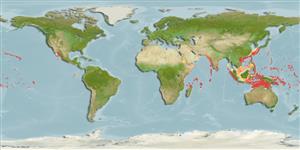Common names from other countries
Teleostei (teleosts) >
Holocentriformes (Squirrelfishes, soldierfishes) >
Holocentridae (Squirrelfishes, soldierfishes) > Myripristinae
Etymology: Myripristis: Greek, myros, -ou = male of morey eel + Greek, pristis = saw (Ref. 45335).
More on authors: Jordan & Evermann.
Environment: milieu / climate zone / depth range / distribution range
Ecology
Marine; benthopelagic; depth range 12 - 350 m (Ref. 58488), usually 30 - 235 m (Ref. 9710). Tropical; 32°N - 15°S
Indo-Pacific: scattered records from Natal, South Africa to Samoa and Hawaiian Islands and Tuamotu Islands, north to southern Japan and the Ogasawara Islands, south to Queensland, Australia.
Size / Weight / Age
Maturity: Lm ? range ? - ? cm
Max length : 25.0 cm TL male/unsexed; (Ref. 2334)
Dorsal
spines
(total): 11;
Dorsal
soft rays
(total): 13-16;
Anal
spines: 4;
Anal
soft rays: 11 - 13. Body is light red; edges of scales slightly darker red; black of opercular membrane extending well below opercular spine; median and pelvic fins a mixture of yellow and red, usually with more yellow. Front of lower jaw fitting into a deep notch in upper jaw when mouth is closed; inner pectoral fin axil naked (Ref. 4538). The only Micronesian soldierfish with bright yellow fins (Ref. 37816).
Inhabits steep outer reef slopes (Ref. 1602). Often seen in caves with the coelacanths in 182- 239 m at Ngazidja (Grand Comoro) Island (Ref. 58472). Nocturnal species (Ref. 75154). Solitary or in groups (Ref 90102). Feeds on zooplanktons (Ref. 89972).
Life cycle and mating behavior
Maturity | Reproduction | Spawning | Eggs | Fecundity | Larvae
Randall, J.E. and D.W. Greenfield, 1996. Revision of the Indo-Pacific holocentrid fishes of the genus Myripristis, with descriptions of three new species. Indo-Pac. Fish. (25):61 p. (Ref. 12419)
IUCN Red List Status (Ref. 130435)
CITES (Ref. 128078)
Not Evaluated
Threat to humans
Harmless
Human uses
More information
Common namesSynonymsMetabolismPredatorsEcotoxicologyReproductionMaturitySpawningFecundityEggsEgg development
ReferencesAquacultureAquaculture profileStrainsGeneticsElectrophoresesHeritabilityDiseasesProcessingMass conversion
Tools
Special reports
Download XML
Internet sources
Estimates based on models
Preferred temperature (Ref.
115969): 14.2 - 28.1, mean 24.2 (based on 756 cells).
Phylogenetic diversity index (Ref.
82804): PD
50 = 0.5000 [Uniqueness, from 0.5 = low to 2.0 = high].
Bayesian length-weight: a=0.01905 (0.00865 - 0.04198), b=3.03 (2.85 - 3.21), in cm Total Length, based on LWR estimates for this Genus-body shape (Ref.
93245).
Trophic level (Ref.
69278): 4.0 ±0.67 se; based on food items.
Resilience (Ref.
120179): High, minimum population doubling time less than 15 months (Preliminary K or Fecundity.).
Fishing Vulnerability (Ref.
59153): Low vulnerability (15 of 100).
